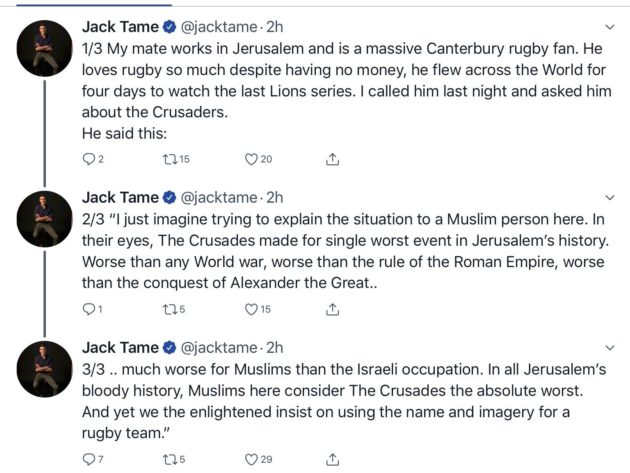Jack Tame needs a history lesson. The Crusades were a response to the military takeover of the holy land by Muslim invaders. The subjugated people begged the Crusaders to ride to the rescue. Terrible things happen in war but that does not change the historical fact that Muslims invaded the Holy land and occupied it.
There were nine separate crusades and Jack Tame seems to be unaware that overall the Muslim forces defeated the Crusaders. Painting the Muslim forces as historical victims does not hold water.
Crusades, military expeditions, beginning in the late 11th century, that were organized by western European Christians in response to centuries of Muslim wars of expansion. Their objectives were to check the spread of Islam, to retake control of the Holy Land in the eastern Mediterranean, to conquer pagan areas, and to recapture formerly Christian territories […]
Between 1095, when the First Crusade was launched, and 1291, when the Latin Christians were finally expelled from their kingdom in Syria, there were numerous expeditions to the Holy Land, to Spain, and even to the Baltic; the Crusades continued for several centuries after 1291. Crusading declined rapidly during the 16th century with the advent of the ProtestantReformation and the decline of papal authority.
britannica.com

For those of you who would enjoy reading more details about the Crusades, a summary is below.
In 1095, Alexius sent envoys to Pope Urban II asking for mercenary troops from the West to help confront the Turkish threat.[…]
In November 1095, at the Council of Clermont in southern France, the Pope called on Western Christians to take up arms to aid the Byzantines and recapture the Holy Land from Muslim control. This marked the beginning of the Crusades.
[…] Those who joined the armed pilgrimage wore a cross as a symbol of the Church.
The Crusades set the stage for several religious knightly military orders, including the Knights Templar, the Teutonic Knights, and the Hospitallers. These groups defended the Holy Land and protected pilgrims traveling to and from the region.[…]
First Crusade (1096-99)
Four armies of Crusaders were formed from troops of different Western European regions […] These groups departed for Byzantium in August 1096.
A less organized band of knights and commoners known as the “People’s Crusade” set off before the others under the command of a popular preacher known as Peter the Hermit.
Ignoring Alexius’ advice to wait for the rest of the Crusaders, Peter’s army crossed the Bosporus in early August. In the first major clash between the Crusaders and Muslims, Turkish forces crushed the invading Europeans at Cibotus.
Another group of Crusaders, led by the notorious Count Emicho, carried out a series of massacres of Jews in various towns in the Rhineland in 1096, drawing widespread outrage and causing a major crisis in Jewish-Christian relations.
[…] In May 1097, the Crusaders and their Byzantine allies attacked Nicea (now Iznik, Turkey), the Seljuk capital in Anatolia. The city surrendered in late June.
The Fall of Jerusalem
[…] After various internal struggles over control of Antioch, the Crusaders began their march toward Jerusalem, then occupied by Egyptian Fatimids (who as Shi’ite Muslims were enemies of the Sunni Seljuks).
Encamping before Jerusalem in June 1099, the Christians forced the besieged city’s governor to surrender by mid-July.
Despite Tancred’s promise of protection, the Crusaders slaughtered hundreds of men, women, and children in their victorious entrance into Jerusalem.
Second Crusade (1147-49)
Having achieved their goal in an unexpectedly short period of time after the First Crusade, many of the Crusaders departed for home. To govern the conquered territory, those who remained established four large western settlements, or Crusader states, in Jerusalem, Edessa, Antioch and Tripoli.
Guarded by formidable castles, the Crusader states retained the upper hand in the region until around 1130, when Muslim forces began gaining ground in their own holy war (or jihad) against the Christians, whom they called “Franks.”
In 1144, the Seljuk general Zangi, governor of Mosul, captured Edessa, leading to the loss of the northernmost Crusader state.
News of Edessa’s fall stunned Europe and caused Christian authorities in the West to call for another Crusade. Led by two great rulers, King Louis VII of France and King Conrad III of Germany, the Second Crusade began in 1147.
That October, the Turks annihilated Conrad’s forces at Dorylaeum, the site of a great Christian victory during the First Crusade.
After Louis and Conrad managed to assemble their armies at Jerusalem, they decided to attack the Syrian stronghold of Damascus with an army of some 50,000 (the largest Crusader force yet).
Damascus’ ruler was forced to call on Nur al-Din, Zangi’s successor in Mosul, for aid. The combined Muslim forces dealt a humiliating defeat to the Crusaders, decisively ending the Second Crusade.
[…] Outrage over these defeats inspired the Third Crusade, led by rulers such as the aging Emperor Frederick Barbarossa […] King Philip II of France, and King Richard I of England (known as Richard the Lionheart).
In September 1191, Richard’s forces defeated those of Saladin in the battle of Arsuf, which would be the only true battle of the Third Crusade.
From the recaptured city of Jaffa, Richard reestablished Christian control over some of the region and approached Jerusalem, though he refused to lay siege to the city.
In September 1192, Richard and Saladin signed a peace treaty that reestablished the Kingdom of Jerusalem (though without the city of Jerusalem) and ended the Third Crusade.
Fourth Crusade: The Fall of Constantinople
Though Pope Innocent III called for a new Crusade in 1198, power struggles within and between Europe and Byzantium drove the Crusaders to divert their mission in order to topple the reigning Byzantine emperor, Alexius III, in favor of his nephew, who became Alexius IV in mid-1203.
The new emperor’s attempts to submit the Byzantine church to Rome was met with stiff resistance, and Alexius IV was strangled after a palace coup in early 1204.
In response, the Crusaders declared war on Constantinople, and the Fourth Crusade ended with the devastating Fall of Constantinople, marked by a bloody conquest, looting and near-destruction of the magnificent Byzantine capital later that year.
Final Crusades (1208-1271)
Throughout the remainder of the 13th century, a variety of Crusades aimed not so much to topple Muslim forces in the Holy Land but to combat any and all of those seen as enemies of the Christian faith.
The Albigensian Crusade (1208-29) aimed to root out the heretical Cathari or Albigensian sect of Christianity in France, while the Baltic Crusades (1211-25) sought to subdue pagans in Transylvania.
[…] In the Fifth Crusade […] the Crusaders attacked Egypt from both land and sea but were forced to surrender to Muslim defenders led by Saladin’s nephew, Al-Malik al-Kamil, in 1221.In 1229, in what became known as the Sixth Crusade, Emperor Frederick II achieved the peaceful transfer of Jerusalem to Crusader control through negotiation with al-Kamil. The peace treaty expired a decade later, and Muslims easily regained control of Jerusalem.
From 1248 to 1254, Louis IX of France organized a crusade against Egypt. This battle, known as the Seventh Crusade, was a failure for Louis.
The Mamluks
As the Crusaders struggled, a new dynasty, known as the Mamluks, descended from former slaves of the Islamic Empire, took power in Egypt. In 1260, Mamluk forces in Palestine managed to halt the advance of the Mongols, an invading force led by Genghis Khan and his descendants, which had emerged as a potential ally for the Christians in the region.
Under the ruthless Sultan Baybars, the Mamluks demolished Antioch in 1268. In response, Louis organized the Eighth Crusade in 1270. The initial goal was to aid the remaining Crusader states in Syria, but the mission was redirected to Tunis, where Louis died.
Edward I of England took on another expedition in 1271. This battle, which is often grouped with the Eighth Crusade but is sometimes referred to as the Ninth Crusade, accomplished very little and was considered the last significant crusade to the Holy Land.
The Crusades End
In 1291, one of the only remaining Crusader cities, Acre, fell to the Muslim Mamluks. Many historians believe this defeat marked the end of the Crusader States and the Crusades themselves.
Though the Church organized minor Crusades with limited goals after 1291—mainly military campaigns aimed at pushing Muslims from conquered territory, or conquering pagan regions—support for such efforts diminished in the 16th century, with the rise of the Reformation and the corresponding decline of papal authority.https://www.history.com/topics/middle-ages/crusades
Effects of the Crusades
While the Crusades ultimately resulted in defeat for Europeans, many argue that they successfully extended the reach of Christianity and Western civilization. […]



